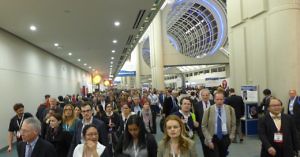Targeting the tumour environment in Lymphomas
As we move from monotherapies to combinations in the immuno-oncology space, we start to see some intriguing ideas being explored from additional checkpoints to vaccines to neoantigens to immune agonists to oncolytic viruses. There are numerous ways to evaluate how to boost or jumpstart more immune cells upfront in the hope of seeing better efficacy.
One way to do this is to better understand the tumour microenvironment.

Wall of people at ASH16 in San Diego
If we know what’s wrong under the hood, we might be better able to make the immune system get going… more gas, faulty starter motor, dead battery, loose wire, broken fan belt? All these things and more might be a problem so you can see that diagnosing the issue up from from basic and translational work might be instructive for clinical trials.
If you don’t know what problem you’re trying to fix or repair then you might as well be throwing mud at the wall. Just as we don’t expect a car mechanic to suggest changing the battery or starter-motor without first diagnosing the issue, so understanding the tumour microenvironment in each different cancer or disease might also be a helpful strategy.
At the recent American Society of Hematology annual meeting (#ASH16), there was a fascinating sceintifc workshop that focused on this very concept – what’s going on under the hood and how do we go about fixing it?
Here we explore these ideas via an interview with a thought leader and specialist in the field. What he had to say was very interesting and candid indeed.
To learn more about these insights, subscribers can log-in
This content is restricted to subscribers